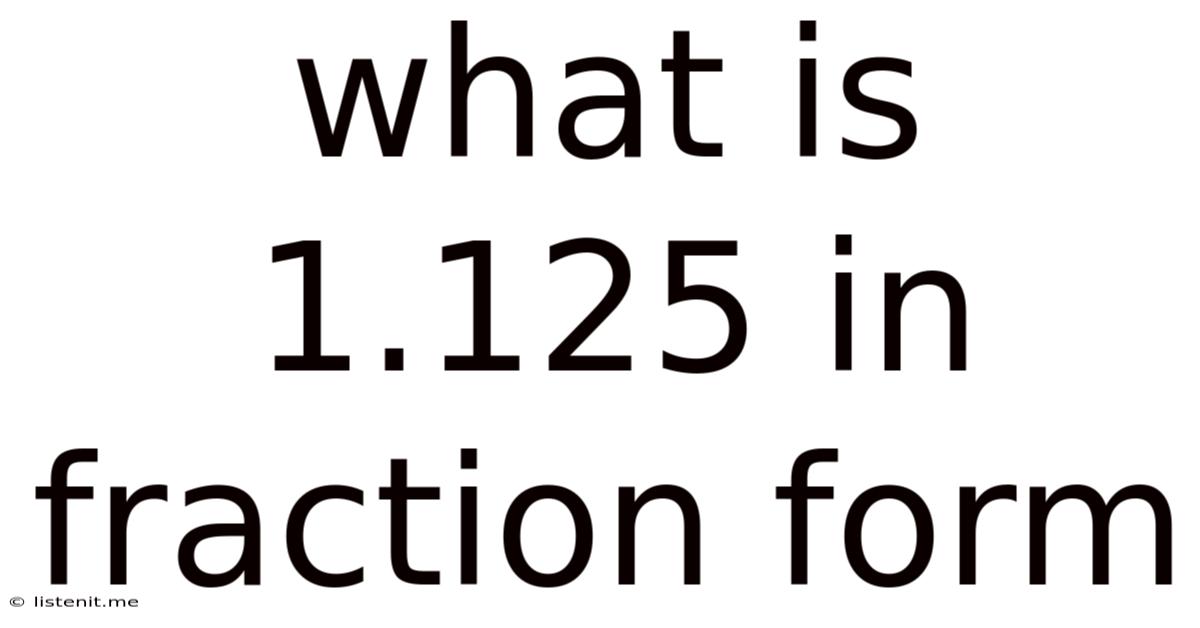What Is 1.125 In Fraction Form
listenit
May 25, 2025 · 4 min read

Table of Contents
What is 1.125 in Fraction Form? A Comprehensive Guide
Converting decimals to fractions might seem daunting at first, but with a systematic approach, it becomes a straightforward process. This comprehensive guide will walk you through converting the decimal 1.125 into its fractional equivalent, explaining the steps in detail and offering valuable insights into working with decimals and fractions. We'll also explore related concepts and provide you with the tools to confidently tackle similar conversions in the future.
Understanding Decimals and Fractions
Before diving into the conversion, let's briefly revisit the fundamentals of decimals and fractions. Decimals represent parts of a whole using a base-ten system, with the decimal point separating the whole number part from the fractional part. Fractions, on the other hand, represent parts of a whole using a numerator (the top number) and a denominator (the bottom number). The denominator indicates the number of equal parts the whole is divided into, and the numerator indicates how many of those parts are being considered.
For example, the fraction 1/2 represents one out of two equal parts, or one-half. The decimal equivalent of 1/2 is 0.5.
Converting 1.125 to a Fraction: A Step-by-Step Approach
The key to converting a decimal to a fraction lies in understanding the place value of each digit after the decimal point. In 1.125:
- 1: Represents one whole unit.
- 1: Represents one-tenth (1/10).
- 2: Represents two-hundredths (2/100).
- 5: Represents five-thousandths (5/1000).
Therefore, 1.125 can be written as the sum of these fractions: 1 + 1/10 + 2/100 + 5/1000.
To combine these fractions into a single fraction, we need a common denominator. The least common multiple of 10, 100, and 1000 is 1000. Therefore, we rewrite the fractions with a denominator of 1000:
1 + 100/1000 + 20/1000 + 5/1000 = 1 + 125/1000
Now, we can convert the whole number 1 into a fraction with a denominator of 1000: 1 = 1000/1000
Adding the fractions together:
1000/1000 + 125/1000 = 1125/1000
This fraction, 1125/1000, represents the fractional form of 1.125.
Simplifying the Fraction
The fraction 1125/1000 can be simplified by finding the greatest common divisor (GCD) of the numerator and denominator. The GCD of 1125 and 1000 is 125. Dividing both the numerator and the denominator by 125:
1125 ÷ 125 = 9 1000 ÷ 125 = 8
Therefore, the simplified fraction is 9/8.
Alternative Method: Using the Place Value Directly
Alternatively, we can directly use the place value of the last digit to determine the denominator. Since the last digit (5) is in the thousandths place, we can write 1.125 as 1125/1000. Then, simplify this fraction as shown above to get 9/8.
Converting Improper Fractions to Mixed Numbers
The fraction 9/8 is an improper fraction because the numerator (9) is greater than the denominator (8). We can convert it to a mixed number, which consists of a whole number and a proper fraction. To do this, we divide the numerator by the denominator:
9 ÷ 8 = 1 with a remainder of 1
This means that 9/8 is equal to 1 and 1/8. So, 1.125 can also be represented as the mixed number 1 1/8.
Practical Applications and Further Exploration
Understanding decimal-to-fraction conversions is crucial in various fields, including:
- Mathematics: Solving equations, simplifying expressions, and working with proportions.
- Engineering: Precision measurements and calculations.
- Cooking and Baking: Measuring ingredients accurately.
- Finance: Calculating interest and percentages.
Further exploration into this topic might include:
- Converting recurring decimals to fractions: This involves a slightly more complex process but utilizes similar principles.
- Working with fractions with different denominators: Mastering the techniques for finding common denominators and adding or subtracting fractions is essential.
- Converting fractions to decimals: This is the inverse operation of what we have covered, and understanding both processes strengthens your overall mathematical skills.
- Using online calculators and tools: While understanding the process manually is vital, using online tools can verify your results and assist with more complex conversions.
Troubleshooting Common Mistakes
A common mistake is incorrectly identifying the place value of the digits after the decimal point. Remember that each position to the right of the decimal represents a decreasing power of 10 (tenths, hundredths, thousandths, ten-thousandths, etc.).
Another common mistake involves forgetting to simplify the fraction to its lowest terms. Always check if the numerator and denominator share any common factors to simplify the fraction and make it easier to work with. Failing to simplify can lead to inaccuracies in further calculations.
Conclusion
Converting 1.125 to its fractional equivalent involves a systematic approach that leverages the understanding of decimal place values and fraction simplification techniques. We have explored two methods to achieve this conversion, resulting in the simplified fraction 9/8 or its mixed number equivalent, 1 1/8. By mastering this conversion process, you enhance your mathematical skills and gain a deeper understanding of the relationship between decimals and fractions, proving invaluable in diverse practical applications. Remember to always simplify your fractions to their lowest terms for accuracy and efficiency. Practice makes perfect, so keep practicing these conversions to build your confidence and proficiency!
Latest Posts
Latest Posts
-
35 Out Of 60 As A Percentage
May 25, 2025
-
What Is 9 6 As A Fraction
May 25, 2025
-
3 4 Divided By 5 6
May 25, 2025
-
How Many Calories To Maintain 240 Lbs
May 25, 2025
-
How Many Days Since December 14
May 25, 2025
Related Post
Thank you for visiting our website which covers about What Is 1.125 In Fraction Form . We hope the information provided has been useful to you. Feel free to contact us if you have any questions or need further assistance. See you next time and don't miss to bookmark.